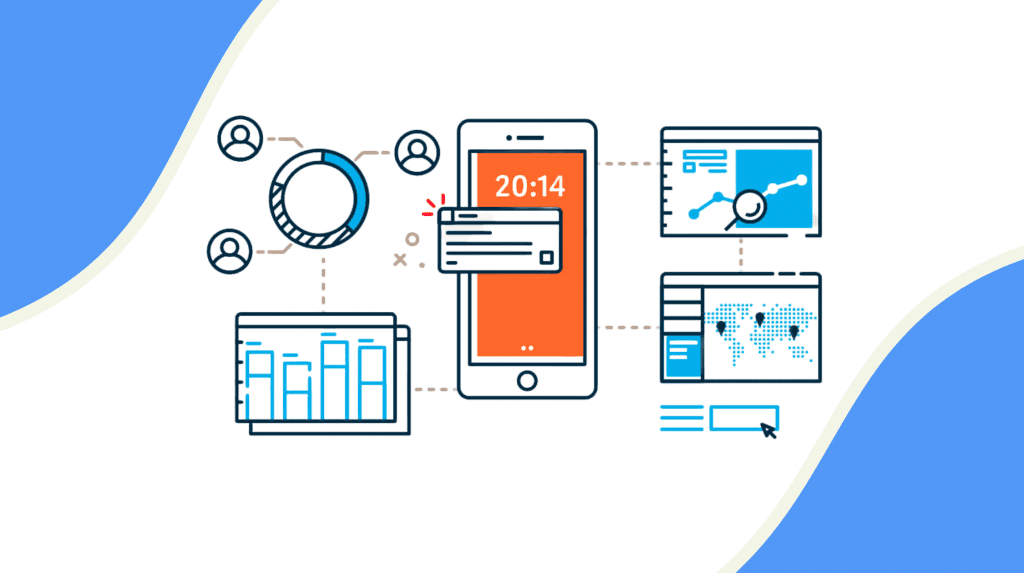
Before we dive into the major analytics in mobile marketing, let us first ask, what mobile marketing really is? In simple words, it is an online marketing strategy targeting a specific audience on smartphones, tablets and related devices. Here, digital marketing takes place through websites, e-mails, social media, mobile apps, SMS or MMS. The major purpose of mobile marketing is to generate quality leads and raise brand awareness.
With the aid of mobile marketing analytics, marketers can track, measure and analyze data on how mobile users interact with your mobile sites, apps etc. This knowledge can prove to be extremely beneficial for marketers to recognise both the success and the failed strategies in mobile marketing.
1. Advertising/ Marketing Analytics
There is a high possibility that most of the target audience won’t even know that your app exists even if you develop an incredible, top-notch app, because, it is through advertising and ad networks that you will be able to attract loyal users- those who install the app, actively engage/use the app and contribute towards the financial elements of the app.
Partnering with multiple ad networks is one of the best strategies to run a successful ad campaign. By doing so, you will be able to increase the installs, engagement and financial metrics of your app. The following are a few marketing analytics (advertising analytics) that will clearly show the performance of your app in the market-
- Installs
- Clicks
- Opens
- Registrations
- Purchases
- Level achieved
- Content viewed
- Custom events
- Shares
- Invites
2. In-App Analytics
Every app caters to a certain goal or objective and the most successful and popular apps are the ones that fulfil these user goals in the simplest manner possible. This is where the in-app analytics, that, is, the data on the way in which each user is behaving inside an app. This data can help marketers to optimize and improvise their app based on user behaviour data.
Some common questions that the marketers can ask to obtain the in-app analytics data-
Device Profile
- What is the type of user device (Mobile Phone/ Tablet/ Other)?
- Who is the manufacturer of the device used by a particular user?
- What is the device’s OS (iOS/ Android/ Windows/ Other)
User Demographics
It involves data on the Location, Gender, Approximate age and the Language spoken by the user. It also helps to find out whether the user is a New or a Returning user.
In-App Behavior
The in-app behaviour of the app users can be comprehensively analysed with the indicators such as buttons clicked, ads clicked, purchases made, levels completed, articles read, screens viewed, etc.
3. Performance Analytics
The performance of the app is another key factor that is crucial for meeting user expectations and user experience. App uptime and App responsiveness are the two key indicators of an app’s performance and no matter how well you have coded your app, there are a few roadblocks in the performance of an app-
Complexity Factor
Several apps have a high dependency on third-party services such as Cloud Storage and Facebook for storage and login respectively. The performance of the app is directly affected by the availability and the speed of third-party services.
Variation in Hardware
Different mobile devices have different hardware specifications. For instance, the iPhone and the iPad vary from each other in their processing power and memory. Similarly, all Android devices do not have uniform hardware, storage or memory specifications. Thus, if an app is available on multiple platforms, its variations should be considered and the marketers must ensure that these variations do not negatively impact the app’s performance.
Device Network
It plays a massive role in the performance of an app. A high-speed network such as the 4G LTE will result in a better app performance as compared to a slower or a low-speed device network.
The following are some of the performance analytics indicators that marketers must use to analyze the performance of their apps-
- Application Programming Interface latency, i.e., it is the time taken by the API system to respond to an API call
- Carrier/network latency
- Errors
- Crashes
- Exceptions
- Data transactions
Final Thoughts
Each of the above-discussed analytics of mobile marketing- Advertising/ Marketing Analytics, In-App Analytics and Performance Analytics, when efficiently utilised by the marketers can drastically improve the quality of their apps and can help them become a pro at mobile marketing.
Through Marketing Analytics, you can allocate your ad spend to the top-performing ad networks and partners. Similarly, with the aid of In-App Analytics, you can get information about your users and their in-app behavior. This data can help you to improve the app’s conversion paths for increasing the quality leads and customers. And, lastly, Performance Analytics can help marketers to monitor the app inefficiencies and it helps maintain the uptime and responsiveness of the app.













